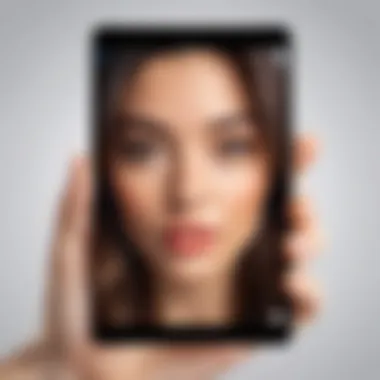Top Selfie Apps: Features and Recommendations


Intro
In a world dominated by social media and instantaneous sharing, the art of the selfie has become a substantial cultural phenomenon. With front-facing cameras, the demand for high-quality selfies continues to rise among enthusiasts and casual users alike. The right applications can elevate this experience beyond the typical snapshot, enhancing not only the image quality but also the creative potential of users. This article aims to guide readers through the best applications available, highlighting their unique features, usability, and the specific needs they address.
Overview of the Technology
Selfie apps have evolved rapidly, embracing advanced technologies to meet the growing expectations of users. From AI-based enhancements to intuitive user interfaces, these tools stand out for various reasons. Understanding the underlying technology can help users appreciate what makes each app special.
Key specifications
Most selfie apps today rely on sophisticated algorithms to analyze facial features. They can automatically adjust lighting, smooth skin, and even add filters with incredible precision. Features such as:
- Real-time beauty filters: Many apps use augmented reality to apply filters live, ensuring users can see the adjustments before snapping the photo.
- Editing tools: Options for cropping, sharpening, and adjusting brightness are standard, but some apps offer more advanced tools like background removal and color correction.
Unique selling points
Each app has attributes that distinguish it from its counterparts. For instance, some emphasize social sharing capabilities by integrating with platforms like Facebook or Instagram, making it easier for users to share their creations instantly. Others focus on specific demographic needs or particular styles, catering to a diverse audience.
The End
As consumers navigate the vast array of selfie apps, understanding the unique attributes and technologies can greatly enhance their choices. By exploring the specifics of each app, users can select their ideal tool for capturing memorable selfies. The journey does not end here; further sections will delve into the actual apps worth considering.
Prologue to Selfie Apps
The rise of selfie culture has transformed how people view photography. Selfie apps play a vital role in this evolution, providing tools that enhance the experience of capturing one's image. In this article, we explore the world of selfie applications, detailing their various features and how they cater to the needs of users. Understanding the significance of these apps helps consumers make informed choices in a crowded market.
Evolution of Selfies
Selfies have a rich history that precedes the digital age. The very first self-portrait dates back to the 1830s, but the modern concept of a selfie blossomed with the advent of smartphones equipped with front-facing cameras. Over the past decade, selfies have evolved from simple snapshots to complex images that reflect individual styles and creativity. Social media platforms have fueled this phenomenon, encouraging users to share their selfies with friends and followers.
Today, selfies represent more than just a personal photograph. They embody self-expression, identity, and social engagement. As technology advanced, so did the features available in selfie apps. From basic filters to advanced image editing tools, the capabilities of these applications have expanded significantly. This evolution has been driven not only by user demand but also by innovations in mobile technology, making high-quality photography accessible to everyone.
Importance of Quality in Selfies
In an age where visual content dominates online interactions, the quality of selfies matters. High-resolution images convey professionalism and artistic merit, attracting more attention on social platforms. Users often look for apps that allow them to produce clear and visually appealing selfies. Quality in selfies can reflect a user’s personality and creativity.
Several factors contribute to the overall quality of a selfie, including lighting, composition, and post-editing. With the right selfie app, users can enhance colors, apply filters, and adjust brightness to create a polished final product. The increase in competitive social media branding has made it essential for individuals, influencers, and brands to focus on presenting high-quality images. Quality selfies can leave lasting impressions, creating connections with viewers and enhancing social media engagement.
"Quality is not an act, it is a habit." – Aristotle
This quote underscores how regular use of quality-enhancing tools and routines in taking selfies can elevate the standard.
Understanding these elements is crucial for anyone looking to refine their selfie-taking experience. Effective selfie apps simplify these processes, making it easier to produce stunning images that resonate in the digital landscape.
Criteria for Selecting the Best Selfie Apps
In a world dominated by visual content, the significance of selecting the right selfie app cannot be overstated. Numerous options exist, yet each app offers a distinct blend of functionalities and user experience. This section will detail the criteria that matter when evaluating selfie apps, shedding light on specific elements, benefits, and considerations.
User Interface and Experience
The interface of a selfie app plays a crucial role in determining its overall usability. A clean, intuitive design allows users to navigate easily without confusion. Ideally, the core features should be accessible within two or three taps. For instance, an app that places camera controls front and center enhances the experience by allowing users to get immediate shots without unnecessary delays.


Moreover, an engaging user experience extends beyond mere visuals. How quickly an app launches and transitions between features affects how often a user will return to it. An app that operates seamlessly on both old and new device models is particularly advantageous, as it accommodates a broader audience.
Editing Features
Editing capabilities are essential for any selfie app. Outstanding apps provide a suite of tools that allow users to enhance their photos with just a few taps. Features like filters, cropping, and color adjustments add value. Advanced options, such as retouching skin and removing blemishes, are also popular. When evaluating an app, one must consider how straightforward these editing features are to utilize.
Additionally, real-time editing capabilities can enhance the user experience. This feature allows adjustments to be made before capturing the selfie, providing instant feedback and enabling users to experiment creatively.
Sharing Options
In our connected lives, the ability to share selfies quickly and effortlessly is critical. Leading selfie apps typically offer robust sharing options. Users should be able to share their captures directly to social platforms like Instagram, Facebook, and Snapchat without cumbersome steps. Moreover, the inclusion of direct messaging options is preferable.
Another important aspect includes the app’s compatibility with various file formats. An app allowing users to save images in high quality or as GIFs can be a game changer. This ensures that the user's creative works maintain their integrity across different mediums.
Compatibility with Devices
Finally, the compatibility of an app with different devices cannot be overlooked. A great selfie app should be functional across various devices, from high-end smartphones to more modest models. Ideally, it should also support both iOS and Android platforms. Users tend to favor apps that do not demand the latest device to function effectively.
In summary, a careful analysis of these criteria will guide users in selecting a selfie app that is both user-friendly and feature-rich. Understanding these elements will not only improve the selfie experience but also assist in making informed decisions when navigating the plethora of app options available today.
Top Selfie Apps Available
In an age where self-expression and visual communication reign supreme, the significance of using the right selfie apps cannot be overstated. The right tool can enhance not only the capture of images but also the overall experience of taking self-portraits. Each app comes with its unique benefits, whether it is offering superior editing tools, a user-friendly interface, or fun filters. Understanding the specifics can help the advanced user select a tailored application that suits personal needs.
These choices can significantly impact the quality of selfies and the enjoyment of the process. Let’s explore some of the top options on the market today.
Camera360
Camera360 stands out for its rich set of features that cater to serious photography enthusiasts. It includes a wide variety of filters, stickers, and special effects that can transform ordinary photos into striking images. Beyond basic capture, Camera360 offers advanced editing tools that users can employ to fine-tune their selfies.
The app's intuitive interface allows for a smooth user experience while navigating through options. One of its notable features is the ability to enhance the skin tone and texture, making it a popular choice among selfie-takers looking for a polished finish.
Facetune
Facetune is arguably the gold standard when it comes to editing selfies. This app allows users to retouch and enhance their images with precision. Its tools are ideal for removing blemishes, whitenin g teeth, and softening skin textures, which appeals to users seeking a heightened level of professionalism in their selfies.
However, it's essential to use such features judiciously. Over-editing can lead to an unnatural appearance. Facetune’s advanced settings provide options for various subtle enhancements, ensuring the final image still reflects reality.
VSCO
For photography enthusiasts who appreciate minimalism, VSCO offers a simple but effective camera app. It provides a range of filters that can give a professional look to selfies. Each filter is crafted to emulate classic film styles, which resonates well with users seeking a more artistic flair.
The editing tools are robust yet straightforward. Users can adjust settings like exposure and contrast efficiently. Additionally, VSCO includes community features that allow users to share their edited photos within a platform of like-minded individuals. This sets it apart as not just a tool, but a creative community.
Snapchat
While often associated with ephemeral messaging, Snapchat has reinvented itself as a selfie powerhouse. Its array of filters and lenses can transform the ordinary into the extraordinary in seconds. From cute animal faces to artful overlays, users can explore endless creative possibilities.
The app's social features allow immediate sharing with friends, making it a favorite among younger demographics. Furthermore, Snapchat's search capabilities mean users can discover new filters, keeping the content fresh and engaging.
Retrica


Retrica is specifically designed for taking selfies, making it a strong contender in this category. With a range of filters available in real-time, users can instantly see how different styles may enhance their selfies. It also includes unique options like timing and layout features, allowing the capture of multiple angles and perspectives.
Retrica fosters creativity by encouraging users to experiment with various styles. Its simplicity is a plus, enabling even tech novices to produce attractive selfies without a steep learning curve.
B612
B612 is another app that has gained popularity due to its entertaining features. It combines beauty filters with an array of fun stickers and effects. This makes it especially appealing for users who wish to add a playful element to their selfies.
The beauty mode is real-time, meaning adjustments can be viewed on-the-fly. This lets users gauge how they want to present themselves before taking the shot. B612 takes into account current trends and frequently updates its features to cater to the dynamic nature of social media needs.
Instagram is not only a social media platform but also an effective app for capturing selfies. Its integrated camera offers various filters and editing tools that permit users to refine their images right before sharing with followers. What makes Instagram unique is its vast community—a space where selfies can garner views and likes from a diverse audience.
The platform is continually updating with new features, enabling users to experiment with video reels and stories. This versatility makes Instagram an essential app for everyone, from casual users to aspiring influencers.
In summary, the choice of selfie app can shape how users express themselves through images. With various options tailored to different skills and preferences, enthusiasts have the freedom to enhance their selfie experiences substantially.
Emerging Trends in Selfie Apps
Emerging trends in selfie apps indicate how technology continues to shape our social interactions and personal expression. These developments are pivotal as they enhance the user experience and redefine how people perceive and engage with selfies. In a competitive landscape, distinguishing features play an essential role in user satisfaction and retention.
Augmented Reality Features
Augmented reality (AR) features are becoming a significant aspect of many selfie apps. They allow users to merge the physical world with digital enhancements seamlessly. With AR, users can apply filters, add effects, or even change backgrounds in real time while capturing their images. This technological advancement transforms ordinary selfies into engaging, interactive experiences.
For example, apps like Snapchat utilize AR to provide users with filters that can transform their appearance or alter their environment dramatically. This capability can enhance creativity and offer a sense of playfulness that keeps users returning for more. Additionally, the integration of AR encourages users to share their images on social media platforms, further amplifying the social aspect of photography.
Benefits of using AR features include:
- Interactive engagement: Users can explore new ways to express themselves.
- Enhanced creativity: The availability of diverse tools ignites creativity in selfie taking.
- Increased shareability: Unique AR-enhanced images have higher potential for virality on social media.
AI-Driven Enhancements
AI-driven enhancements are another groundbreaking trend in selfie applications. Artificial intelligence is utilized to improve picture quality, provide smart editing tools, and suggest optimal angles for capturing selfies. With intelligent algorithms, these apps can analyze the user’s image and recommend adjustments for lighting, contrast, and beauty filters. This data-driven approach assures users obtain the best possible results without extensive manual editing.
Moreover, AI can automate aspects of the editing process, allowing users to refine images with just a few taps. For instance, Facetune employs AI to retouch photos, making it easier for users to achieve their desired look efficiently. This convenience appeals to busy individuals who still want to maintain a polished online presence.
Some aspects of AI-driven enhancements include:
- Real-time suggestions: Instant feedback on how to improve the selfie.
- Personalized filters: Tailored effects based on user preferences and facial features.
- Automated retouching: Streamlined processes that enhance images to a professional level with minimal effort.
As the photography landscape evolves, these trends set a foundation for future advancements.
By understanding these emerging trends, users can better navigate the selfie app market and choose applications that align with their evolving needs.
Analyzing User Feedback
Understanding user feedback is essential to selecting the right selfie app. Users share opinions based on their experiences, giving insights about performance and features. Ratings and reviews can help potential users navigate through numerous options. They provide specific feedback on usability, editing tools, and overall satisfaction. Not all apps are perfect for everyone, so user experiences highlight strengths and weaknesses. For example, one app may be great for filters while another excels in social integration. Feedback presents a broad perspective, allowing readers to make informed choices based on collective experiences.


User Ratings and Reviews
User ratings and reviews serve as a barometer of an app's quality. A high rating often indicates a positive overall reception, but it’s important to read individual reviews. Users may detail their personal usage, explaining what they liked or disliked. This can reveal nuances in functionality that may not be apparent otherwise. For instance, one review might emphasize a particular app’s user-friendly interface, while another could point out sluggish performance during heavy use.
Some platforms, like the Google Play Store or Apple App Store, encourage users to rate their experiences. Each app gets an average score, which emphasizes overall user satisfaction. However, potential users should be cautious. Sometimes reviews stem from isolated experiences or might be incentivized, creating false impressions. Consider looking for prevailing trends across multiple reviews rather than singular opinions.
Trends in User Preferences
Analyzing trends in user preferences allows for an understanding of what features individuals prioritize in selfie apps. Emerging functionalities can signal shifts in consumer behavior. For instance, many users may now seek advanced editing tools, reflecting a demand for higher-quality images. Others may prefer straightforward, no-fuss interfaces that prioritize ease of use.
Features such as augmented reality filters and AI enhancements are also gaining traction. These innovative tools appeal to tech-savvy individuals who are always looking for the latest technology in their photography apps.
Social sharing capabilities have also become crucial, as users often want to share their selfies across multiple platforms. Understanding these preferences offers valuable insight for anyone looking to enhance their selfie-taking experience, making it easier to align their needs with an appropriate app.
"User feedback provides essential information that guides potential users towards the most suitable selfie applications."
Overall, exploring user ratings, reviews, and trends gives clarity to the landscape of selfie apps, enabling informed decisions.
Comparison of Leading Selfie Apps
In the digital landscape, smartphones are pivotal in self-expression, with selfies playing a crucial role in how individuals portray themselves. This makes the comparison of leading selfie apps essential. By understanding the nuances of different applications, users can make informed choices tailored to their needs. The right app can elevate a simple photograph into a work of art, depending on features, ease of use, and overall performance.
Analyzing various selfie apps allows us to discern specific elements that set them apart. What capabilities do they offer? How intuitive is their user interface? These considerations are crucial for both casual users and enthusiasts who want to enhance their photography experience. Moreover, the usability of these apps varies, making the choice highly personal. Knowing these differences can significantly impact the quality of selfies.
Camera360 vs. VSCO
When comparing Camera360 and VSCO, it's important to examine their core features and the unique benefits each provides.
Camera360 is well-known for its extensive filter options and powerful editing tools. Users can access a variety of effects that can drastically alter their images, offering a fun and engaging way to enhance pictures. It includes options for adjusting brightness, contrast, saturation, and more. In addition, Camera360 also offers an intuitive interface, which makes it accessible for those who might not be tech-savvy.
On the other hand, VSCO takes a more minimalist approach to photo editing. It emphasizes aesthetics and simplicity over an abundance of filters. The app is favored for its high-quality presets and advanced editing options. Users who value a refined, artistic touch often gravitate toward VSCO. Its community-based platform allows users to share their work and discover inspiration from others.
Both apps cater to different types of users. If personality and creativity in editing are crucial, Camera360 might be the better choice. Conversely, for those who prefer subtle enhancements and a more classic style, VSCO shines as an excellent alternative.
Facetune vs. Snapchat
Comparing Facetune and Snapchat reveals distinct purposes and functionalities tailored to different selfie enthusiasts.
Facetune is specifically designed for photo retouching. Users can smooth skin, whiten teeth, and make other enhancements that create a polished, ideal image. This app appeals to those who desire perfection in their selfies, often used for social media profiles and special occasions. The control over editing is quite comprehensive, offering various tools that allow for precise adjustments.
In contrast, Snapchat focuses on the immediacy of capturing moments and sharing them. With its fun filters and effects, it prioritizes spontaneity. Users can instantly apply various playful elements to their selfies, providing a light-hearted and whimsical feel. Snapchat fosters a sense of connection and engagement, as images disappear after a set time, encouraging users to focus on the experience rather than perfection.
Both applications serve unique purposes. Facetune caters to those who want to curate a flawless online persona. Meanwhile, Snapchat captivates users seeking authenticity and playful expression. Understanding these differences is key to selecting the selfie app that aligns with personal preferences.
End
In this article, we have taken a comprehensive look at selfie apps. Understanding the best options available is crucial for anyone keen on perfecting their photography. A well-selected app can enhance clarity, introduce fun features, and offer valuable editing tools. Knowing what to look for in a selfie app can improve overall user experience, making the process more enjoyable and productive.
Future of Selfie Apps
The future of selfie apps is promising, characterized by a blend of creativity and technology. Emerging trends suggest a shift toward more personalized experiences. Apps will likely integrate advanced AI features. This innovation will allow for real-time enhancements, adapting to user preferences and lighting conditions.
Moreover, augmented reality will play a significant role, offering new ways for users to engage with their environment through their selfies. Users can expect better filters, 3D effects, and immersive backgrounds. Connections to social media platforms will deepen, with tools providing seamless sharing options.
The continuous evolution of selfie apps indicates that they will remain relevant for a long time. Tech-savvy individuals and gadget lovers will benefit from exploring these changes. The right app will not only capture stunning images but also facilitate creative expression.
"The trend of mobile photography is set to grow, and keeping up will enhance the experience for users."







